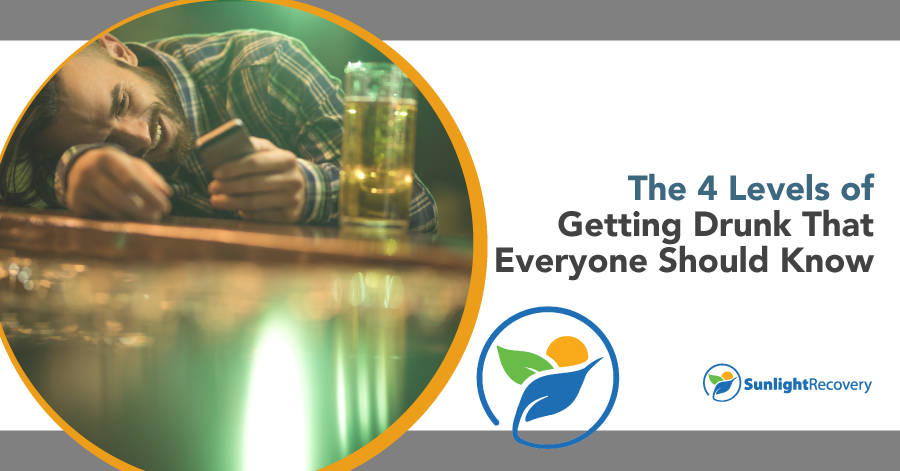Alcohol is a widely accepted drug and has been for a long time. People have been using alcohol throughout human history, and proponents of the “drunken monkey hypothesis” even suggest that drunkenness began with our primate ancestors. They suggest that the tendency for primates to get drunk on decomposing fruit might partially explain humanity’s fondness for using alcohol, a drug that has extreme potential for harm. Perhaps, like us, our primate ancestors also experienced distinct stages of being drunk. From feeling light and euphoric to being totally stupefied, getting drunk happens in discrete stages alongside important changes in our brain.
This article covers the health risks of drinking alcohol and what’s happening in the brain during the four stages of drunkenness.
Health Risks of Drinking Alcohol
Health risks from drinking alcohol can be short- or long-term and may vary depending on the amount of alcohol consumed. Short-term risks include impaired judgment, reduced coordination and slurred speech. Long-term risks include liver damage, heart disease and cancer. Drinking alcohol can also interfere with certain medications, and it can contribute to accidents and injuries.
Additionally, government statistics show that alcohol contributes to about 18.5% of emergency hospital visits and 22% of opioid-related deaths. With approximately 95,000 annual alcohol-related deaths, it’s the third leading cause of preventable death in the United States. For these reasons, it’s important to drink alcohol in moderation or abstain from drinking altogether.
The Effects of Alcohol on Body and Brain
When you drink alcohol, it quickly passes from your stomach and enters your bloodstream. Once in your bloodstream, the alcohol travels to your brain, where it interferes with the way nerve cells communicate. This interference affects your ability to think clearly and make good decisions. It also affects your coordination and balance, which is why people who are drunk often seem unsteady on their feet. As more alcohol enters your system, you begin to feel relaxed and even dizzy.
Your speech may become slurred, and you may have trouble remembering things that happened while you were drunk. In extreme cases, alcohol poisoning can occur, which can be life-threatening. Long-term alcohol use can affect the way your brain looks and works and lead to many negative health consequences, including liver damage, faster aging and hypertension.
The Four Stages of Being Drunk
As you get more drunk and your blood alcohol concentration (BAC) increases, you move through at least four discrete stages of drunkenness. Each stage of being drunk has distinct characteristics:
- The buzz/euphoria stage. Once a person’s BAC level is between 0.03% and 0.12%, they enter this stage of drunkenness. A BAC within this range indicates that the individual has drunk more than one beer in an hour. For men, this usually translates to two to three drinks, while for women it often represents one to two beers. A person may feel more at ease, talkative and self-assured during this first feel-good phase. Depending on factors like age, quantity of food consumed and body weight, they may feel a light, euphoric buzz, a precursor to being tipsy.
- The excitement stage. A person reaches this stage when their BAC is 0.09%-0.25%. They may have problems remembering things and overstate or exaggerate emotional reactions. They may also lose some coordination abilities and find it more difficult to balance or walk in a straight line. Their judgment and vision may also become impaired.
- The confusion stage. This is an advanced stage of drunkenness with a BAC range of 0.18%-0.30%. For men, this means drinking five or more drinks per hour, four or more for women. At this stage, a person is at risk of blood poisoning, and the brain and body begin to shut down. A person might have difficulty speaking, walking or standing up and may begin going in and out of consciousness.
- The stupor stage. If your BAC is 0.30% or more, you’re at a high risk of experiencing a deadly alcohol poisoning. Loss of control over body functions, comas, seizures and respiratory arrest are just a few symptoms of being drunk in this extreme, often fatal stage of drunkenness. At this stage, your gag reflex will no longer function, and you’re at risk of choking to death on vomit.
While many people feel alcohol is harmless, the last two stages of being drunk are very dangerous. In the final stage, immediate medical attention is imperative.
Brain Changes in the Four Stages
The four stages described above correspond to neurological changes.
- Stage 1: The cerebral cortex. Most voluntary muscular actions are started by the cerebral cortex, which also processes sensory information and cognition and controls lower brain areas. When alcohol affects this area, it may result in inhibition, encourage gregariousness and elevate self-confidence. It can also distort perception.
- Stage 2: The cerebellum. This brain area is responsible for rhythm, coordination, movement and fine movement. When this brain area is affected by alcohol, the drinker may experience a loss of coordination and balance or difficulty executing certain movements.
- Stage 3: The hypothalamus and pituitary gland. These glands regulate several automatic bodily processes. Alcohol decreases the activity of the hypothalamic nerve centers that regulate sexual arousal, making you more excited but less able to perform. As alcohol inhibits pituitary secretion, which affects urine excretion and makes your kidneys unable to absorb water, it causes you to urinate more frequently.
- Stage 4: The medulla. When a person has drunk to this dangerous stage, the brain’s medulla is affected. Important bodily processes like respiration, temperature regulation and heart rate are all under the autonomic control of the medulla. A person may experience sleepiness and start to lose consciousness once alcohol has reached the medulla. The shutdown of the medulla would be deadly but is possible if a person reaches this stage or beyond.
Achieve Alcohol-Free Living
While alcohol remains a socially accepted drug of abuse, it has many risks for physical and mental well-being. Risks may vary depending on how much alcohol has been consumed and which stage of drunkenness a person is in. The first two stages of being drunk are more common and less dangerous, ranging from a light euphoria to excitement and exaggeration. The latter two stages are more dangerous, with the final stage leading to fatalities in the absence of medical attention.
If you or someone you know is suffering from a dangerous alcohol addiction, don’t hesitate to reach out for help. Contact us today by calling (888) 402-3647. Our compassionate team of counselors is standing by to take your call 24/7. Take the first step to recovery today.






